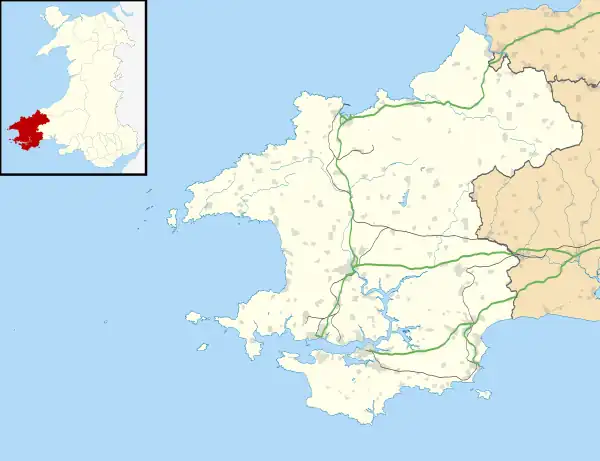Haroldston St. Issell's
Haroldston St Issells is a former parish[1] in Pembrokeshire, Wales, on the upper reaches of the Western Cleddau, 1 mile (1.6 km) southeast of Haverfordwest. Its area is 1,104 acres (447 ha); Haroldston church is co-located with Lower Haroldston and is a small attractive building. Haroldston ruins and Lower Haroldston can both be viewed from a circular walk along the banks of the Cleddau. Haroldston and other places in the parish are preserved as historic place names by the Royal Commission.[2]
| Haroldston St Issells | |
|---|---|
 St Issell's Church, Haroldston | |
 Haroldston St Issells Location within Pembrokeshire | |
| Population | 1,103 |
| OS grid reference | SM945144 |
| Principal area | |
| Preserved county | |
| Country | Wales |
| Sovereign state | United Kingdom |
| Post town | HAVERFORDWEST |
| Postcode district | SA61 |
| Dialling code | 01437 |
| Police | Dyfed-Powys |
| Fire | Mid and West Wales |
| Ambulance | Welsh |
| UK Parliament | |
History
Manor
Haroldston Manor was the seat of firstly the Harold family and then the Perrot family,[3] including Sir John Perrot,[4] thought to be the illegitimate son of Henry VIII. It appears (as Harroldston) on a 1578 parish map of Pembrokeshire.[5] Upper and Lower Haroldston are two ancient farmhouses that were probably part of the Haroldston estate. Lower Haroldston is still a working farm, whilst Upper Haroldston is a domestic dwelling. Haroldstone House, described by Coflein as "once one of the grandest houses in the county of Pembrokeshire" is now a ruin, but its origins are medieval,[6] going back at least to the 12th century.[7] The remnants of the gardens and grounds are designated Grade II on the Cadw/ICOMOS Register of Parks and Gardens of Special Historic Interest in Wales.[8]
In 1643, Haroldston was garrisoned by Royalist troops with the presumed support of Herbert Perrot. The following year he changed sides, risking the destruction of his property, but the King's cause faltered. By the restoration, he had changed sides again and was knighted.[9]
Population
The population of the parish reported in 1833 was 304.[4] In 1872, it was reported as 281, in 59 houses.[10]
Mining
Ochre was mined at Greenhill Ochre Mine to the south south east of Merlins Bridge from 1911 until about 1915, then abandoned by 1919. In 1994 it was excavated to bedrock level for capping to safeguard Haverfordwest building expansion.[11]
References
- "GENUKI: Parish map 89". Retrieved 4 March 2021.
- "RCAHMW: List of historic place names: Harolston St Issells". Retrieved 4 March 2021.
- "Perrot family of Haroldston". Dictionary of Welsh Biography. National Library of Wales. Retrieved 4 March 2021.
- "GENUKI: Haroldston St Issells". Retrieved 30 December 2018.
- "Penbrok comitat". British Library. Retrieved 26 September 2020.
- "Haroldston House, Haverfordwest (22040)". Coflein. RCAHMW. Retrieved 29 September 2021.
- "The History of Parliament: Perrot (Parret), John of Haroldston". Retrieved 4 March 2021.
- Cadw. "Haroldston (PGW(Dy)20(PEM))". National Historic Assets of Wales. Retrieved 6 February 2023.
- "Pembrokeshire Historical Society: The Archive and Pembrokeshire 'Connection'of the Pakingtons of Westwood". Retrieved 4 March 2021.
- "University of Portsmouth, History of Haroldston St Issell in Pembrokeshire: A Vision of Britain through Time". Retrieved 4 March 2021.
- Claughton, Peter (1999). A List of Mines in Pembrokeshire. Exeter University.
- "National Archives: Haroldston, St Issell and Hamlet of St Thomas Parish Council 1962-1974". Retrieved 4 March 2021.
- "Dyfed FHS: St Issell (Church in Wales)". Retrieved 4 March 2021.